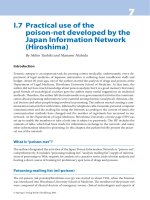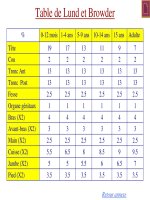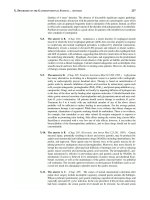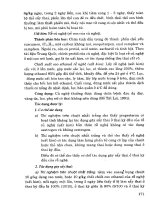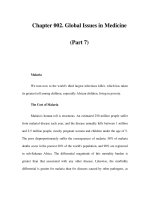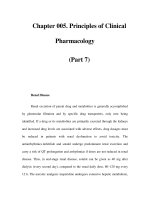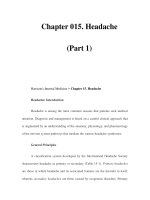Chapter 015. Headache (Part 7) pptx
Bạn đang xem bản rút gọn của tài liệu. Xem và tải ngay bản đầy đủ của tài liệu tại đây (57.33 KB, 5 trang )
Chapter 015. Headache
(Part 7)
Migraine Headaches: Treatment
Once a diagnosis of migraine has been established, it is important to assess
the extent of a patient's disease and disability. The Migraine Disability Assessment
Score (MIDAS) is a well-validated, easy-to-use tool (Fig. 15-4).
Figure 15-4
Patient education is an important aspect of migraine management.
Information for patients is available at www.achenet.org, the website of the
American Council for Headache Education (ACHE).
It is helpful for patients to understand that migraine is an inherited
tendency to headache; that migraine can be modified and controlled by lifestyle
adjustments and medications, but it cannot be eradicated; and that, except in some
occasions in women on oral estrogens or contraceptives, migraine is not associated
with serious or life-threatening illnesses.
Nonpharmacologic Management
Migraine can often be managed to some degree by a variety of
nonpharmacologic approaches. Most patients benefit by the identification and
avoidance of specific headache triggers.
A regulated lifestyle is helpful, including a healthful diet, regular exercise,
regular sleep patterns, avoidance of excess caffeine and alcohol, and avoidance of
acute changes in stress levels.
The measures that benefit a given individual should be used routinely since
they provide a simple, cost-effective approach to migraine management. Patients
with migraine do not encounter more stress than headache-free individuals;
overresponsiveness to stress appears to be the issue.
Since the stresses of everyday living cannot be eliminated, lessening one's
response to stress by various techniques is helpful for many patients. These may
include yoga, transcendental meditation, hypnosis, and conditioning techniques
such as biofeedback.
For most patients, this approach is, at best, an adjunct to pharmacotherapy.
Nonpharmacologic measures are unlikely to prevent all migraine attacks. When
these measures fail to prevent an attack, pharmacologic approaches are then
needed to abort an attack.
Acute Attack Therapies for Migraine
The mainstay of pharmacologic therapy is the judicious use of one or more
of the many drugs that are effective in migraine (Table 15-5). The selection of the
optimal regimen for a given patient depends on a number of factors, the most
important of which is the severity of the attack.
Mild migraine attacks can usually be managed by oral agents; the average
efficacy rate is 50–70%. Severe migraine attacks may require parenteral therapy.
Most drugs effective in the treatment of migraine are members of one of
three major pharmacologic classes: anti-inflammatory agents, 5HT
1B/1D
receptor
agonists, and dopamine receptor antagonists.
